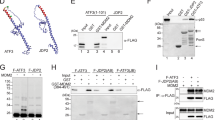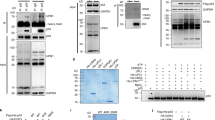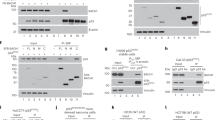Abstract
Hausp is a deubiquitinase that has been shown to regulate the p53–Mdm2 pathway. Cotransfection of p53 and Hausp stabilizes p53 through the removal of ubiquitin moieties from polyubiquitinated p53. Interestingly, knockout or RNA interference-mediated knockdown of Hausp in human cells also resulted in the stabilization of p53 due to the destabilization of Mdm2, suggesting a dynamic role of Hausp in p53 activation. To understand the physiological functions of Hausp, we generated hausp knockout mice. Hausp knockout mice die during early embryonic development between embryonic days E6.5 and E7.5. The hausp knockout embryos showed p53 activation, but no apparent increase in apoptosis. Embryonic lethality was caused by a dramatic reduction in proliferation and termination in development, in part due to p53 activation and/or abrogation of p53-independent functions. Although deletion of p53 did not completely rescue the embryonic lethality of the hausp knockout, embryonic development was extended in both hausp and p53 double knockout embryos. These data show that Hausp has a critical role in regulating the p53–Mdm2 pathway.
This is a preview of subscription content, access via your institution
Access options
Subscribe to this journal
Receive 50 print issues and online access
$259.00 per year
only $5.18 per issue
Buy this article
- Purchase on Springer Link
- Instant access to full article PDF
Prices may be subject to local taxes which are calculated during checkout








Similar content being viewed by others
References
Amerik AY, Li S, Hochstrasser M . (2000). Analysis of the deubiquitinating enzymes of the yeast Saccharomyces cerevisiae. Biol Chem 381: 981–992.
Babu JR, Jeganathan KB, Baker DJ, Wu X, Kang-Decker N, van Deursen JM . (2003). Rae1 is an essential mitotic checkpoint regulator that cooperates with Bub3 to prevent chromosome missegregation. J Cell Biol 3: 341–353.
Becker K, Marchenko ND, Palacios G, Moll UM . (2008). A role of HAUSP in tumor suppression in a human colon carcinoma xenograft model. Cell Cycle 7: 1205–1213.
Chen D, Kon N, Li M, Zhang W, Qin J, Gu W . (2005). ARF-BP1/Mule is a critical mediator of the ARF tumor suppressor. Cell 121: 1071–1083.
Chen X, Ko LJ, Jayaraman L, Prives C . (1996). p53 levels, functional domains, and DNA damage determine the extent of the apoptotic response of tumor cells. Genes Dev 1: 2438–2451.
Cummins JM, Rago C, Kohli M, Kinzler KW, Lengauer C, Vogelstein B . (2004). Tumour suppression: disruption of HAUSP gene stabilizes p53. Nature 428: 1.
Dornan D, Wertz I, Shimizu H, Arnott D, Frantz GD, Dowd P et al. (2004). The ubiquitin ligase COP1 is a critical negative regulator of p53. Nature 429: 86–92.
Everett RD, Meredith M, Orr A . (1999). The ability of herpes simplex virus type 1 immediate-early protein Vmw110 to bind to a ubiquitin-specific protease contributes to its roles in the activation of gene expression and stimulation of virus replication. J Virol 73: 417–426.
Hershko A, Ciechanover A . (1998). The ubiquitin system. Annu Rev Biochem 67: 425–479.
Holowaty MN, Sheng Y, Nguyen T, Arrowsmith C, Frappier L . (2003). Protein interaction domains of the ubiquitin-specific protease, USP7/HAUSP. J Biol Chem 278: 47753–47761.
Hong S, Kim SJ, Ka S, Choi I, Kang S . (2002). USP7, a ubiquitin-specific protease, interacts with ataxin-1, the SCA1 gene product. Mol Cell Neurosci 20: 298–306.
Hu M, Li P, Li M, Li W, Yao T, Wu JW et al. (2002). Crystal structure of a UBP-family deubiquitinating enzyme in isolation and in complex with ubiquitin aldehyde. Cell 111: 1041–1054.
Hu M, Gu L, Li M, Jeffrey PD, Gu W, Shi Y . (2006). Structural basis of competitive recognition of p53 and MDM2 by HAUSP/USP7: implications for the regulation of the p53-MDM2 pathway. PLoS Biol 4: e27.
Jones SN, Roe AE, Donehower LA, Bradley A . (1995). Rescue of embryonic lethality in Mdm2-deficient mice by absence of p53. Nature 378: 206–208.
Laney JD, Hochstrasser M . (1999). Substrate targeting in the ubiquitin system. Cell 14: 427–430.
Leng RP, Lin Y, Ma W, Wu H, Lemmers B, Chung S et al. (2003). Pirh2, a p53-induced ubiquitin-protein ligase, promotes p53 degradation. Cell 112: 779–791.
Li E, Bestor TH, Jaenisch R . (1992). Targeted mutation of the DNA methyltransferase gene results in embryonic lethality. Cell 69: 915–926.
Li M, Chen D, Shiloh A, Luo J, Nikolaev AY, Qin J et al. (2002). Deubiquitination of p53 by HAUSP is an important pathway for p53 stabilization. Nature 416: 648–653.
Li M, Brooks CL, Kon N, Gu W . (2004). A dynamic role of HAUSP in the p53-Mdm2 pathway. Mol Cell 13: 879–886.
Meulmeester E, Maurice MM, Boutell C, Teunisse AF, Ovaa H, Abraham TE et al. (2005). Loss of HAUSP-mediated deubiquitination contributes to DNA damage-induced destabilization of Hdmx and Hdm2. Mol Cell 18: 565–576.
Montes de Oca Luna R, Wagner DS, Lozano G . (1995). Rescue of early embryonic lethality in mdm2-deficient mice by deletion of p53. Nature 378: 203–206.
Mori S, Ito G, Usami N, Yoshioka H, Ueda Y, Kodama Y et al. (2004). p53 apoptotic pathway molecules are frequently and simultaneously altered in nonsmall cell lung carcinoma. Cancer 100: 1673–1682.
Niendorf S, Oksche A, Kisser A, Löhler J, Prinz M, Schorle H et al. (2007). Essential role of ubiquitin-specific protease 8 for receptor tyrosine kinase stability and endocytic trafficking in vivo. Mol Cell Biol 27: 5029–5039.
Nijman SM, Luna-Vargas MP, Velds A, Brummelkamp TR, Dirac AM, Sixma TK et al. (2005). A genomic and functional inventory of deubiquitinating enzymes. Cell 123: 773–786.
Pickart CM, Eddins MJ . (2004). Ubiquitin: structures, functions, mechanisms. Biochim Biophys Acta 29: 55–72.
Sherr CJ, Webber JD . (2000). The ARF/p53 pathway. Curr Opin Genet Dev 10: 94–99.
Sowa ME, Bennett EJ, Gygi SP, Harper JW . (2009). Defining the human deubiquitinating enzyme interaction landscape. Cell 23: 389–403.
Tang J, Qu LK, Zhang J, Wang W, Michaelson JS, Degenhardt YY et al. (2006). Critical role for Daxx in regulating Mdm2. Nat Cell Biol 8: 855–862.
van der Horst A, de Vries-Smits AM, Brenkman AB, van Triest MH, van den Broek N, Colland F et al. (2006). FOXO4 transcriptional activity is regulated by monoubiquitination and USP7/HAUSP. Nat Cell Biol 8: 1064–1073.
van der Knaap JA, Kumar BR, Moshkin YM, Langenberg K, Krijgsveld J, Heck AJ et al. (2005). GMP synthetase stimulates histone H2B deubiquitylation by the epigenetic silencer USP7. Mol Cell 17: 695–707.
Wu X, Kasper LH, Mantcheva RT, Mantchev GT, Springett MJ, van Deursen JM . (2001). Disruption of the FG nucleoporin NUP98 causes selective changes in nuclear pore complex stoichiometry and function. Proc Natl Acad Sci USA 13: 3191–3196.
Acknowledgements
We thank Qiong Li and Xi Sun for their expert assistance with histology. We also thank Dr Chi-Ming Li for helpful suggestions. This study was supported in part by a postdoctoral fellowship from NIH to NK and grants from NIH/NCI to TL and WG.
Author information
Authors and Affiliations
Corresponding author
Rights and permissions
About this article
Cite this article
Kon, N., Kobayashi, Y., Li, M. et al. Inactivation of HAUSP in vivo modulates p53 function. Oncogene 29, 1270–1279 (2010). https://doi.org/10.1038/onc.2009.427
Received:
Revised:
Accepted:
Published:
Issue Date:
DOI: https://doi.org/10.1038/onc.2009.427
Keywords
This article is cited by
-
Inhibition of USP7 induces p53-independent tumor growth suppression in triple-negative breast cancers by destabilizing FOXM1
Cell Death & Differentiation (2023)
-
The equilibrium of tumor suppression: DUBs as active regulators of PTEN
Experimental & Molecular Medicine (2022)
-
Deubiquitylases in developmental ubiquitin signaling and congenital diseases
Cell Death & Differentiation (2021)
-
Ubiquitin-Specific-Processing Protease 7 Regulates Female Germline Stem Cell Self-Renewal Through DNA Methylation
Stem Cell Reviews and Reports (2021)
-
USP7 negatively controls global DNA methylation by attenuating ubiquitinated histone-dependent DNMT1 recruitment
Cell Discovery (2020)



